2020版高考英语刷题高分提能组合练 (14)
2020版高考英语刷题高分提能组合练 (8)
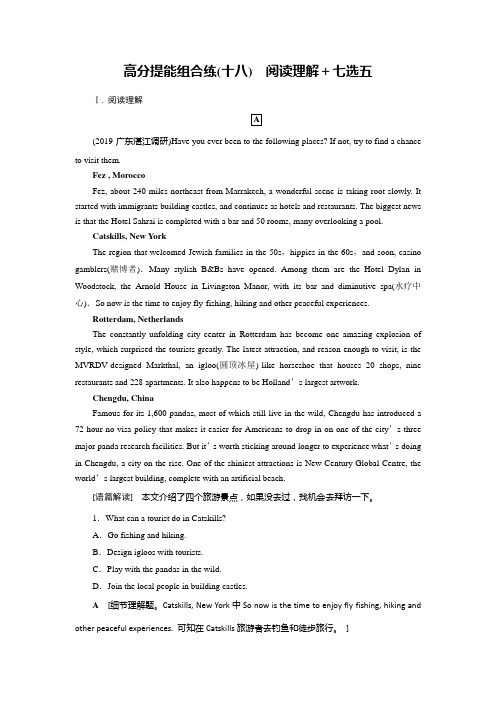
高分提能组合练(十八)阅读理解+七选五Ⅰ. 阅读理解A(2019·广东湛江调研)Have you ever been to the following places? If not, try to find a chance to visit them.Fez , MoroccoFez, about 240 miles northeast from Marrakech, a wonderful scene is taking root slowly. It started with immigrants building castles, and continues as hotels and restaurants. The biggest news is that the Hotel Sahrai is completed with a bar and 50 rooms, many overlooking a pool.Catskills, New YorkThe region that welcomed Jewish families in the 50s,hippies in the 60s,and soon, casino gamblers(赌博者).Many stylish B&Bs have opened. Among them are the Hotel Dylan in Woodstock, the Arnold House in Livingston Manor, with its bar and diminutive spa(水疗中心).So now is the time to enjoy fly-fishing, hiking and other peaceful experiences.Rotterdam, NetherlandsThe constantly unfolding city center in Rotterdam has become one amazing explosion of style, which surprised the tourists greatly. The latest attraction, and reason enough to visit, is the MVRDV-designed Markthal, an igloo(圆顶冰屋)-like horseshoe that houses 20 shops, nine restaurants and 228 apartments. It also happens to be Holland’s largest artwork.Chengdu, ChinaFamous for its 1,600 pandas, most of which still live in the wild, Chengdu has introduced a 72-hour no-visa policy that makes it easier for Americans to drop in on one of the city’s three major panda research facilities. But it’s worth sticking around longer to experience what’s doing in Chengdu, a city on the rise. One of the shiniest attractions is New Century Global Centre, the world’s largest building, complete with an artificial beach.[语篇解读]本文介绍了四个旅游景点,如果没去过,找机会去拜访一下。
2020版高考英语总复习高考提能练四十四含解析外研版选修

When we do gardening we need to use different ingredients to grow plants. Some of them are natural resources like water, soil, sunshine, and many things like this. Using these resources smartly is a part of sustainable gardening. Some simple techniques include: use less water and organic things to grow plants; try to store rainwater so that you can use them for gardening; try using less energy to drive devices; avoid using plastics in any form while gardening; reuse the leaves from your garden to fertilize them. These are the basic sustainable measures. To do so we need to have proper knowledge about gardening and its requirements so that we can use proper resources without wasting any of them.
2020版高考英语总复习高考提能练十四含解析外研版必修
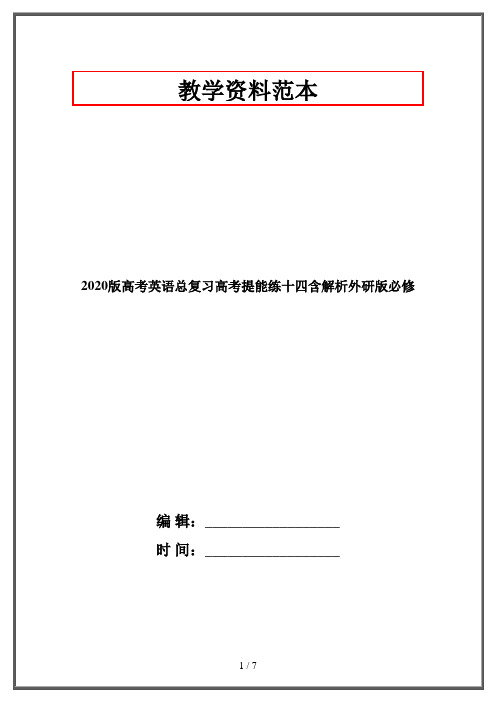
C.Have it repaired. D.Get it coded.
答案与解析:A 考查细节理解和分析能力。根据第二段第三句“NO MEALS SHALL BE PROVIDED WITHOUT PRESENTATION OF A VALID MEAL CARD OR CASH”可知,如无法提供有效的餐卡或现金,将无法用餐。据此可知,餐卡失效时使用现金支付也可以正常用餐,故A项正确。
3.What does Naasih mean by saying “You're shining, Leon” in the last paragraph?
A.Leon is an inspiration to him.
B.Leon has changed his state of mind.
C.Leon is popular among the children.
2020版高考英语总复习高考提能练十四含解析外研版必修
编 辑:__________________
时 间:_____________xx·银川质检] Recently I accepted a challenge to join Naasih, a motivational speaker, on a voyage through India designed to refresh my spirit. After too many hours, Naasih and I arrived in the slum (贫民窟) just as the sun was breaking across the smoggy Delhi sky. It seemed as if the small houses extended for miles, an ocean of tin roofs and laundry lines.
2020高考英语刷题冲刺双一流系列:(题型突破)题型三完形填空习题
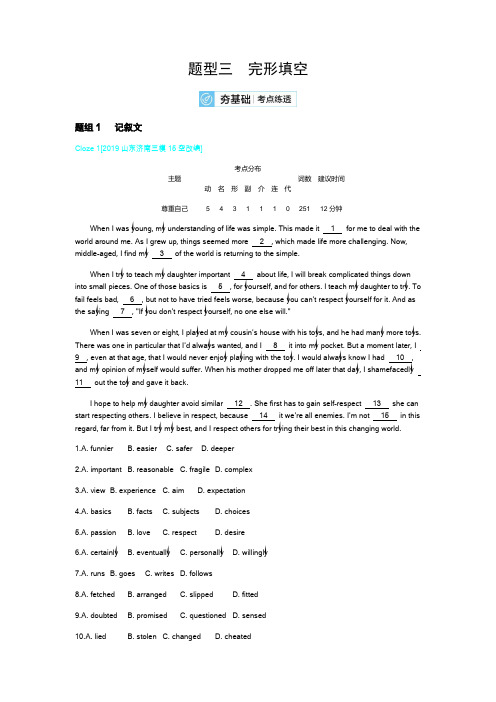
题型三完形填空题组1 记叙文Cloze 1[2019山东济南三模15空改编]主题考点分布词数建议时间动名形副介连代尊重自己543111025112分钟When I was young, my understanding of life was simple. This made it 1for me to deal with the world around me. As I grew up, things seemed more 2, which made life more challenging. Now, middle-aged, I find my 3of the world is returning to the simple.When I try to teach my daughter important 4about life, I will break complicated things down into small pieces. One of those basics is 5, for yourself, and for others. I teach my daughter to try. To fail feels bad,6, but not to have tried feels worse, because you can’t respect yourself for it. And as the saying 7, "If you don’t respect yourself, no one else will."When I was seven or eight, I played at my cousin’s house with his toys, and he had many more toys. There was one in particular that I’d always wanted, and I 8it into my pocket. But a moment later, I 9, even at that age, that I would never enjoy playing with the toy. I would always know I had 10, and my opinion of myself would suffer. When his mother dropped me off later that day, I shamefacedly 11out the toy and gave it back.I hope to help my daughter avoid similar 12. She first has to gain self-respect 13she can start respecting others. I believe in respect, because 14it we’re all enemies. I’m not 15in this regard, far from it. But I try my best, and I respect others for trying their best in this changing world.1.A. funnier B. easier C. safer D. deeper2.A. important B. reasonable C. fragile D. complex3.A. view B. experience C. aim D. expectation4.A. basics B. facts C. subjects D. choices5.A. passion B. love C. respect D. desire6.A. certainly B. eventually C. personally D. willingly7.A. runs B. goes C. writes D. follows8.A. fetched B. arranged C. slipped D. fitted9.A. doubted B. promised C. questioned D. sensed10.A. lied B. stolen C. changed D. cheated11.A. gave B. left C. pulled D. handed12.A. accidents B. mistakes C. results D. habits13.A. before B. until C. in case D. now that14.A. upon B. beyond C. without D. despite15.A. honest B. casual C. curious D. perfectCloze 2[2019山东青岛三模15空改编]主题考点分布词数建议时间动名形副介连代捐赠823200025312分钟A couple in ordinary clothes walked into the Harvard’s outer office. "We want to see the president," the man said softly. "He will be busy all day," the secretary spoke 1, concluding that the couple had no 2with Harvard from what they wore. "We’ll wait," the lady replied.Four hours later, the couple didn’t go away. And the secretary grew 3and finally decided to disturb the president. Someone of 4obviously had no time to spend with nobodies, and he 5 people in such clothes filling in his outer office.The president, frozen-faced, walked proudly toward the couple. The lady told him, "We had a son that 6Harvard for one year. He loved Harvard and was very happy here. But he was accidentally 7. And my husband and I would like to 8 a memorial (纪念物) to him somewhere on campus." The president wasn’t9; he was shocked. "Madam," he said 10, "we can’t put up a statue for every person who studied in Harvard and died.""Oh, no," the lady 11quickly. "In fact, we thought we would give a building to Harvard." The president 12at the couple and then shouted, "A building!Do you know how much a building costs? The cost of the Harvard’s buildings is over 7.5 million dollars."For a moment the lady was 13. Then she turned to her husband and said quietly, "Is that all it costs to 14 a university?" Her husband nodded. Mr. and Mrs. Stanford walked away, traveling to Palo Alto, California, where they established the university 15after them — a memorial to a son.1.A. impatiently B. excitedly C. enthusiastically D. awkwardly2.A. concern B. problem C. interest D. business3.A. embarrassed B. grateful C. annoyed D. upset4.A. importance B. action C. character D. age5.A. invited B. observed C. thanked D. hated6.A. affected B. attended C. admitted D. abandoned7.A. killed B. dismissed C. disabled D. forgotten8.A. keep B. buy C. build D. leave9.A. disappointed B. sensitive C. touched D. deserved10.A. curiously B. delightedly C. sadly D. coldly11.A. explained B. apologized C. changed D. argued12.A. smiled B. glanced C. pointed D. laughed13.A. desperate B. amazed C. ambitious D. silent14.A. buy B. start C. access D. develop15.A. named B. looking C. followed D. takingCloze 3[2019山东聊城二模15空改编]主题考点分布词数建议时间动名形副介连代失而复得734100024612分钟I believe our life is full of luck and kindness.I was out in town with my husband. Because of the cold, my 1shrunk, causing my anniversary ring to 2.I didn’t notice this until we got home. I became 3ill and ached all over. I thought my husband was going to have a heart attack.Although it is a material item, it is yet very 4. He went out and retraced our 5to where we came back. I called the stores we were in and no one turned it in. I thought it was 6for sure.Well, at around midnight last night, our dogs went mad. We have a sunroom 7to our home. The door to that is usually 8 .But that night, we left it unlocked. My all-terrain motor scooter(小型摩托车) was 9out there. In its basket was a ring box — holding my ring!There was also a note that told the story of this stranger 10the ring and recognizing the work, as it is a piece made particularly. The person then went to the jeweler and 11about finding the ring. The jeweler is a friend of mine so she gave her my 12and the town is so small, we are 13to find. The stranger who found the ring 14the ribbon(丝带) in the store in order to keep the ring around the finger when it is 15out. And then the stranger also left a card for us to take our family out to the movies as a gift.1.A. ring B. hand C. brain D. finger2.A. fall off B. leave behind C. break down D. go away3.A. firmly B. formally C. identically D. physically4.A. valuable B. challenging C. memorable D. beneficial5.A. footprints B. steps C. streets D. directions6.A. gone B. stolen C. changed D. transformed7.A. adapted B. attached C. exposed D. held8.A. open B. abandoned C. closed D. locked9.A. made B. parked C. repaired D. destroyed10.A. handling B. exploring C. finding D. chasing11.A. explained B. complained C. wondered D. argued12.A. phone number B. photo C. mailbox D. name13.A. difficult B. easy C. incredible D. complex14.A. purchased B. tore C. sold D. borrowed15.A. warm B. rainy C. foggy D. coldCloze 4[2019山东烟台、菏泽5月考试15空改编]主题考点分布词数建议时间动名形副介连代生日礼物454110023712分钟Two years ago, my friend and I were at college. With his birthday quickly approaching, he came to me with an unusual1: instead of receiving presents, he wanted to do some acts of kindness.I was2for such an idea.Giving instead of taking for the birthday was really difficult. I asked him how he could come up with such a3idea. He told me about a TED talk he had watched on generosity, which had inspired him. So we started to4creative things we could do.Our university employed some security guards to 5its students. They have to work6, keeping watch on every corner throughout the university. For the most part it’s a thankless job as most people grow 7to seeing the guards all around and eventually barely notice their 8, let alone acknowledge their efforts. How could we show them our appreciation?We decided to make a large pot of hot 9. We hired a Uber and asked the driver to take us around the campus where we knew the 10would be and we poured them each a cup of hot chocolate. The Uber driver was 11 a bit doubtful to the entire plan but after a while he was helping us 12the guards and our lively spirit had 13to him as well. We were met with many 14and appreciative words. It was amazing to see how a 15act or even intention of generosity can lift everyone’s spirit.1.A. order B. request C. problem D. story2.A. stuck B. blessed C. burdened D. bored3.A. traditional B. complex C. familiar D. novel4.A. plan out B. take over C. watch for D. hold back5.A. judge B. help C. monitor D. protect6.A. step by step B. around the clockC. more or lessD. now and then7.A. addicted B. devoted C. attached D. accustomed8.A. presence B. hunger C. poverty D. thirsty9.A. tea B. milk C. porridge D. chocolate10.A. workers B. students C. guards D. drivers11.A. finally B. initiallyC. occasionallyD. frequently12.A. remind B. track C. spot D. recognize13.A. spread B. moved C. happened D. returned14.A. friends B. difficulties C. greetings D. smiles15.A. similar B. small C. daily D. modestCloze 5[原创15空]主题考点分布词数建议时间动名形副介连代重拾读书的乐趣743100021912分钟28-year-old Jermaine Scott set up in business as a barber in Madison, Tennessee, about a year ago. He gradually noted the kids were1to tablets and cell phones when they came to the barbershop. It was2to cut their hair when they were focused on those. That led to the3of Scott’s "Barbershop Books Day", when kids could come and get a4haircut. What was required? They had to5 a book while they got it.He created "Barbershop Books Day" to help not only the kids, but also the parents. Madison has many low-income families and many are focused on just keeping their6on. For people in this community, $15 for a haircut per kid is not easy to7, so in some way a reduction in the price can8.Scott began his initiative(倡议) by9five library books and putting them near his chair. Book10 began pouring in when a local news station got11of what he was doing. Scott plans on taking his initiative a step further by12his "Barbershop Books Day" to an "Ice Breaker Book Tour" where he 13to get kids excited to learn while also giving them14role models through motivational speakers. Scott said, "If I step outside my comfort zone and tell them school is cool, 15it will guide them in the right direction."1.A. adapted B. reduced C. glued D. accustomed2.A. safe B. hard C. possible D. pleasant3.A. advertisement B. supportC. celebrationD. birth4.A. satisfied B. discounted C. free D. thorough5.A. borrow B. purchase C. read D. choose6.A. hands B. hair C. shirt D. lights7.A. overlook B. afford C. believe D. decline8.A. arise B. compensate C. count D. progress9.A. checking on B. checking overC. checking inD. checking out10.A. contents B. titles C. orders D. donations11.A. wind B. hold C. sight D. chance12.A. expanding B. applying C. comparing D. adding13.A. agrees B. intends C. deserves D. proves14.A. typical B. classic C. positive D. alternative15.A. generally B. certainlyC. accordinglyD. hopefullyCloze 6[2020湖北八校联考]主题考点分布词数建议时间动名形副介连代特殊经历1061210041916分钟Last Sunday,there was no dirt in the air,only bright spring sunshine and a clear blue sky.In the afternoon,Papa headed out to the field to check on the cattle while Mama started cleaning the house.Faye and I played in the yard.The temperature suddenly dropped — it felt good.The 1had been building since dawn.Then Mama shouted from the 2,"Iris,you and Faye get inside quickly now!"I looked to the west and saw a huge cloud of black 3,like thick smoke from a railway engine’s chimney.All the birds flew away."Faye,go with Mama!" I 4."I’ll warn Papa."Faye ran toward the house.The sandstorm hit so fast that I 5saw her climb the porch(门廊)steps.In a short time,the day turned into night.I 6for Papa,hoping my voice would lead him back.The dirt and sand stung my face like a thousand bees.I needed to get to a shelter. 7my face with one hand,I made my way toward the car and opened the door.Dirt flew in with me as I pulled the door closed.Papa was still out there!I needed to help him 8the car.I searched the dashboard(仪表板) and found the switch for the front 9.They made some rays,but would Papa see them in the thick 10? I pushed the horn(喇叭) again and again,hoping Papa would hear it.11,Papa’s face appeared at the window.My heart jumped with surprise and 12.He opened the door and climbed onto the seat next to me.He coughed and wiped his eyes with dirty hands,then pulled me into his arms."Oh,Iris,you’re13."I hugged Papa and 14.I could feel the tears streaming down my dirty cheeks.Papa 15my face and asked,"Your mother and Faye?" I said,"They are in the house." Papa nodded,"Good. We’ll wait out the sandstorm here."Papa shut off the car’s lights and I worried the dirt would 16us.Finally,the wind died down and the dust started to 17.Papa kicked against the door,opening it far enough to let us out.We went home as Mama 18out."Mama!" I shouted and ran into her arms."Oh,my precious Iris!"Mama cried."You and Papa are safe!""I’m safe 19Iris,"Papa said."The car’s horn led me to the shelter.""I’m so proud of you,"Mama said to me.I cried even more then,but the tears I shed were tears of joy because our family had 20the horrible sandstorm.1.A. sand B. thunder C. heat D. snow2.A. school B. house C. field D. car3.A. fog B. gas C. steam D. dust4.A. stated B. complained C. suggested D. shouted5.A. hardly B. constantlyC. reallyD. surprisingly6.A. screamed B. waitedC. lookedD. searched7.A. Cleaning B. TouchingC. CoveringD. Rubbing8.A. fix B. findC. recognizeD. drive9.A. lights B. handlesC. wheelsD. windows10.A. smoke B. darknessC. forestD. atmosphere11.A. Curiously B. DisappointedlyC. SuddenlyD. Unexpectedly12.A. relief B. warmthC. excitementD. bravery13.A. handsome B. cautiousC. safeD. impressive14.A. smiled B. whisperedC. relaxedD. cried15.A. glared at B. looked atC. swept overD. reached for16.A. bury B. leaveC. hurtD. poison17.A. spread B. multiplyC. settleD. double18.A. walked B. slippedC. laughedD. dashed19.A. rather than B. apart fromC. thanks toD. other than20.A. survived B. defeatedC. experiencedD. caused Cloze 7[2020广东七校第二次联考]主题考点分布词数建议时间动名形副介连代志愿者服务675101030915分钟My most rewarding experience in the past two years was volunteering at the swimming competition of Special Olympics where a disabled friend of my community took part.This had special1for me because experiencing it helped improve my leadership skills,develop my character,and support my community.Firstly,my2skills developed when I independently told each swimmer where to3at the platform. And I4each competitor when they needed to swim.I had to make sure that the swimmerswere5and ready to compete.This kept me on my feet at all times and6of each event’s time and location.I learned each swimmer’s name, 7many of them swam in more than one event.Secondly,my8was greatly influenced.When I saw the swimmers get their awards for winning each swimming event,I was deeply moved.I was9by most swimmers who could swim better than I.Their10attitudes astonished me,whether they won or lost.This also broadened myhorizons,offering me the opportunity to11people I would normally not run into.I went out of my12 zone and did whatever was needed to be done,even if it was sometimes difficult for me.It was especially 13when I saw the smiling faces of the competitors.Lastly,I was of14to my community by lending a hand to this organization.To be a part of it gave me a chance to improve my community and become15with the people living in this area.As Winston Churchill once said,"We make a living by what we get,but we make a(n) 16by what we give."The importance of17should be stressed throughout our life.18,through the opportunities my community has offered I was privileged to be19in this exciting and important event in these competitors’ lives.I hope to be a(n) 20again at this event in years to come.1.A. purpose B. attentionC. regulationD. meaning2.A. speaking B. swimmingC. leadershipD. exercise3.A. line up B. pile upC. put upD. set up4.A. informed B. awardedC. taughtD. compared5.A. preserved B. positionedC. presentedD. predicted6.A. full B. ignorantC. convincedD. aware7.A. if B. becauseC. soD. though8.A. technique B. imaginationC. characterD. figure9.A. impressed B. remindedC. blamedD. concerned10.A. various B. controversialC. changeableD. positive11.A. educate B. commandC. meetD. recommend12.A. comfort B. safetyC. timeD. development13.A. outstanding B. rewardingC. interestingD. demanding14.A. wisdom B. courageC. encouragementD. service15.A. crowded B. combinedC. acquaintedD. supplied16.A. exception B. wayC. analysisD. life17.A. volunteering B. evaluatingC. travelingD. competing18.A. Strangely B. GenerallyC. FortunatelyD. Specially19.A. committed B. involvedC. devotedD. caught20.A. director B. assistantC. competitorD. trainerCloze 8[2020河南开封一模]主题考点分布词数建议时间动名形副介连代偶遇好心人863210030916分钟On a Monday morning, back in 2015, I remembered parking my car outside my doctor’s clinic in Broadwater, Western Australia. I felt 1and I carefully practiced what I wanted to tell my doctor. Heartbreak, sorrow and the loss of a complete family left me not coping well.I was 2. I had tried to pick myself up, tried to throw myself into my work as an educator in before- and after-school care, and also tried to focus on my art. 3these efforts, my depressionhadn’t gone away. It kept 4like a cancer in my inner world. I wanted a normal 5. I wanted to be as healthy as my son, Kai, who was 6me. I took a few deep breaths and went into the clinic for my 7.After I returned to my car, I shut the door and started 8uncontrollably. My doctor said I had severe depression. I needed to take antidepressants(抗抑郁药). I had to make some big 9to get better.Still sobbing, I was 10to hear a knock on my car door. A slim lady with short fair hair 11 opened it and began to speak calmly and kindly to me. "I don’t know what you’re12right now. But I wish you well. I believe you will be 13and what you are going through will pass finally," she said. "Can I give you a hug?"There I was, a weeping mess,14accepting this kind stranger’s comforting hug. All I 15to reply in a choked(哽咽的) voice was "Thank you".This is the most significant act of 16that I’ve ever experienced from a stranger. It gave me hope. My 17started right there.About a year later, I bumped into the same 18at the opening of an art exhibition. She 19 me and smiled. She said she could tell I was doing well. We 20again, and once more I expressed my appreciation for her act.1.A. confident B. proud C. nervous D. patient2.A. ashamed B. astonished C. depressed D. confused3.A. Without B. Despite C. Beyond D. Through4.A. growing B. surviving C. moving D. wandering5.A. excuse B. life C. job D. reward6.A. looking for B. waiting forC. walking aroundD. depending on7.A. school B. neighborhoodC. houseD. appointment8.A. coughing B. weepingC. laughingD. shaking9.A. preparations B. commentsC. changesD. contributions10.A. surprised B. delightedC. disappointedD. excited11.A. quickly B. madlyC. gentlyD. casually12.A. describing B. observingC. determiningD. experiencing13.A. left behind B. looked afterC. called onD. turned off14.A. calmly B. eagerlyC. unwillinglyD. gratefully15.A. managed B. decidedC. failedD. attempted16.A. courage B. kindnessC. wisdomD. devotion17.A. treatment B. experimentC. recoveryD. adventure18.A. lady B. doctorC. educatorD. girl19.A. recognized B. forgaveC. understoodD. comforted20.A. met B. noddedC. actedD. huggedCloze 9[2020四省八校质量检测]主题考点分布词数建议时间动名形副介连代热爱冲浪不放弃864200028315分钟My son Leon’s passion for surfing began at the age of 13. After school each day, he put on his wetsuit and swam out to challenge his 1.One afternoon, my husband Wilson was informed that Leon’s eye got badly 2by his board.Wilson rushed Leon to the 3room. He received 26 stitches (缝线)from the corner of his eye to the bridge of his nose.I was flying home while Leon’s eye was being stitched. Wilson drove 4to the airport after they left the doctor’s office. He greeted me at the gate, saying Leon was waiting in the 5."Leon?" I thought the waves must have been 6that day."He had an accident, but he’s going to be 7."A traveling working mother’s worst nightmare had come true. I 8to the car so fast that the heel of my shoe broke off.And I saw my youngest son having a patch over his 9and leaning toward me 10,"Oh, Mom,I’m so glad you’re home. "I also cried in his arms telling him how 11I felt about not being there."It’s okay, Mom," he comforted me. "You don’t know how to surf 12. ""What?" I asked, 13by his logic."I’ll be fine. The doctor says I can go back in the 14in eight days."I wanted to tell him he wasn’t allowed to go near water again, but instead I 15my tongue, hoping he would forget about 16.For the next seven days he kept pressing me to let him surf again. "Mom, you taught us never to 17what we love." After 18"No" for the 100th time, finally I gave in.Back then Leon was just a boy with a(n)19for surfing. Now he’s a man with a strong sense of responsibility, ranking among the top 25 professional surfers in the world.Passionate people 20what they love and never give up.1.A. teachers B. companions C. relatives D. parents2.A. injured B. infected C. influenced D. worsened3.A. conference B. waiting C. observation D. emergency4.A. simply B. normally C. directly D. gradually5.A. car B. room C. hall D. counter6.A. favorable B. terrible C. smooth D. brilliant7.A. competent B. impatient C. fine D. wrong8.A. flew B. ran C. crawled D. jumped9.A. eye B. jaw C. cheek D. forehead10.A. approving B. arguing C. crying D. blaming11.A. astonished B. fortunate C. privileged D. awful12.A. anywhere B. somewhatC. somehowD. anyway13.A. embarrassed B. frustratedC. confusedD. depressed14.A. home B. school C. water D. game15.A. bit B. clicked C. found D. loosened16.A. performing B. recitingC. learningD. surfing17.A. give out B. give up C. give off D. give away18.A. declaring B. repeating C. responding D. criticizing19.A. passion B. inspiration C. awareness D. expectation20.A. claim B. forgive C. convince D. hugCloze 10[2019晋冀鲁豫中原名校三模]主题考点分布词数建议时间动名形副介连代重新规划路线865100027215分钟A few years ago my wife and I took a trip to Costa Rica. Upon arrival we 1 a car and headed for our first destination which was a few hours away. I had a 2so I figured I could manage. After about 20 minutes’ drive I found myself practically 3in the unmarked streets and dirty roads. Upset, I turned to the navigation app on my phone for help.I typed the 4of our destination on my phone and instantly it 5the best route(路线) to get there and we were on our way.The only 6was that things didn’t always go the way I had thought they would. With the streets not being well 7, I would sometimes miss a turn and drive in a 8direction. Luckily, the app never got 9with me. Any time I missed a turn it would simply 10and say, "Recalculating the route. 11the route." And within a few seconds, it would have a new route 12to get us to our destination.Sometimes the new route meant I had to 13to the right turn and sometimes it found a different route that took my new location into 14. Eventually we made it to our hotel 15and enjoyed some beautiful scenery along the way.Most people make the 16of thinking that success and happiness come from someone setting a goal and then 17straight towards it. The 18is that there is no straight path to success. There isn’t even the 19path. There are many paths that can get you to your goals. You just have to be 20to recalculate your route when you miss a turn or there is something in your way.1.A. produced B. repaired C. rented D. purchased2.A. car B. phone C. compass D. map3.A. absorbed B. lost C. experienced D. free4.A. address B. approach C. receipt D. schedule5.A. polished B. discovered C. opened D. managed6.A. fear B. difference C. sympathy D. problem7.A. marked B. paved C. arranged D. expanded8.A. illegal B. new C. wrong D. potential9.A. generous B. mad C. concerned D. cautious10.A. break down B. cut inC. get upD. go away11.A. Abandoning B. CancelingC. ReachingD. Changing12.A. checked B. updated C. adjusted D. planned13.A. point B. lead C. return D. apply14.A. order B. direction C. account D. place15.A. safely B. frequently C. hungrily D. gradually16.A. mistake B. excuse C. accident D. trouble17.A. accumulating B. withdrawingC. marchingD. fleeing18.A. answer B. truth C. condition D. privilege19.A. first B. suitable C. accurate D. only20.A. willing B. proud C. anxious D. ambitious题组2 夹叙夹议文Cloze 11[2019山东潍坊统考15空改编]主题考点分布词数建议时间动名形副介连代正确看待不幸643101022012分钟Sitting at a table in my school cafeteria, I looked around, slowly taking in everything. Student after student passed my1carrying that day’s lunch, but if you looked deeper, there was more to 2.There was more than just the uniform they were wearing, or the way they had styled their hair that day. There was a lot more hidden under the 3.Catching the eye of a girl in my grade sitting at a nearby table, I waved politely. She smiled 4and then continued to pick at the spaghetti in front of her. If I hadn’t5recently that her mother was dying of leukemia, I would have never 6anything was wrong and I may not have been as 7and sympathetic, either. It suddenly 8me that we judge others too quickly without knowing the whole story.I have an incurable lung disease. No one at our school knows — I don’t show any noticeable 9 except for a few coughs here and there. I go about my day like any other kid,10with the realization that I have a 11and terrifying future.Before that day when I decided to 12the world with a new perspective, I 13myself almost every day. I thought only about myself and my heavy 14. But I’ve now realized no one is 15—we just need to accept the way we are.1.A. order B. room C. table D. cafeteria2.A. observe B. imagine C. compare D. exchange3.A. surface B. uniformC. rulesD. circumstances4.A. casually B. weakly C. happily D. impatiently5.A. found B. noticed C. heard D. decided6.A. suspected B. remembered C. predicted D. regretted7.A. outstanding B. willingC. demandingD. understanding8.A. escaped B. satisfied C. hit D. attracted9.A. symptoms B. diseasesC. complaintsD. weaknesses10.A. and B. but C. or D. so11.A. bright B. dark C. real D. serious12.A. change B. create C. view D. tolerate13.A. pitied B. forgaveC. challengedD. encouraged14.A. debt B. reward C. burden D. workload15.A. changeable B. perfectC. uniqueD. different Cloze 12[2020陕西百校联考]主题考点分布词数建议时间动名形副介连代杜绝不良"竞争"962120026915分钟I was cycling and noticed a person, about a quarter of a kilometer in front of me. I could tell he was cycling a little slower than me and 1to try to catch up with him. I had about a kilometer to go on the road 2turning off.So I 3cycling faster and faster and every 4, I was gaining on him just a little bit. After just a few minutes I was only about 100 yards 5him, so I really picked up the pace and 6myself. You would have 7I was cycling in the last section of the London Olympic triathlon.8I caught up with him and passed him. On the inside I felt so 9.I beat him, of course, but he didn’t even know we were 10.After I passed him, I 11that I had been so focused on competing against him that I had 12 my turn. I had gone nearly six blocks past it and had to turn around and go all the way back.Isn’t that what happens in life when we 13competing with co-workers, neighbors, and friends, trying to 14that we are more successful or more important? We spend our time and 15chasing after them and we miss out on our own 16to our future.The17of unhealthy competition is that it’s a never-ending 18. And there will always be somebody ahead of you, someone with a 19job, more money and a better education, etc.Therefore, just take what life has given you, your height, weight and personality. Stay focused and live a peaceful life. There’s no 20in life. Run your own race and wish others well!1.A. failed B. decided C. agreed D. forgot2.A. before B. after C. unless D. when3.A. stopped B. enjoyed C. started D. regretted4.A. way B. block C. step D. time5.A. apart from B. above C. ahead of D. behind6.A. comforted B. protected C. pushed D. supported7.A. thought B. remembered C. dreamt D. hoped8.A. Apparently B. Surprisingly C. Fortunately D. Finally9.A. calm B. lucky C. astonished D. good10.A. racing B. exercising C. celebrating D. cycling11.A. believed B. expected C. realized D. understood。
2019-2020年高中英语高考提能练Unit2Cloning仿真检测灵活拆组卷新人教版
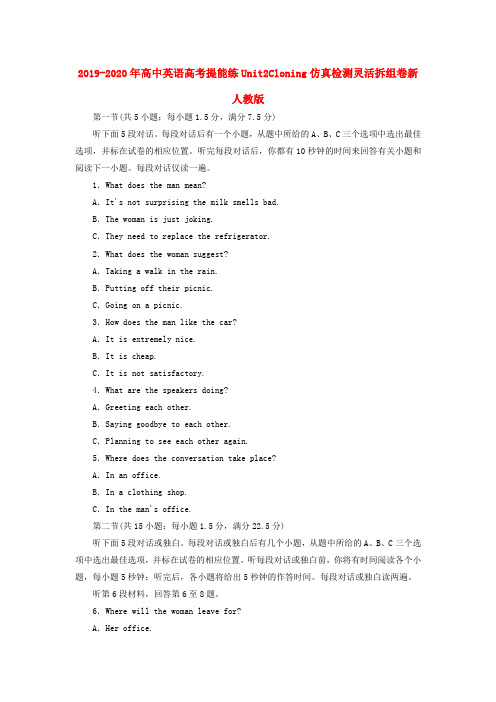
2019-2020年高中英语高考提能练Unit2Cloning仿真检测灵活拆组卷新人教版第一节(共5小题;每小题1.5分,满分7.5分)听下面5段对话。
每段对话后有一个小题,从题中所给的A、B、C三个选项中选出最佳选项,并标在试卷的相应位置。
听完每段对话后,你都有10秒钟的时间来回答有关小题和阅读下一小题。
每段对话仅读一遍。
1.What does the man mean?A.It's not surprising the milk smells bad.B.The woman is just joking.C.They need to replace the refrigerator.2.What does the woman suggest?A.Taking a walk in the rain.B.Putting off their picnic.C.Going on a picnic.3.How does the man like the car?A.It is extremely nice.B.It is cheap.C.It is not satisfactory.4.What are the speakers doing?A.Greeting each other.B.Saying goodbye to each other.C.Planning to see each other again.5.Where does the conversation take place?A.In an office.B.In a clothing shop.C.In the man's office.第二节(共15小题;每小题1.5分,满分22.5分)听下面5段对话或独白。
每段对话或独白后有几个小题,从题中所给的A、B、C三个选项中选出最佳选项,并标在试卷的相应位置。
听每段对话或独白前,你将有时间阅读各个小题,每小题5秒钟;听完后,各小题将给出5秒钟的作答时间。
2020版高考英语刷题高分提能组合练 (13)
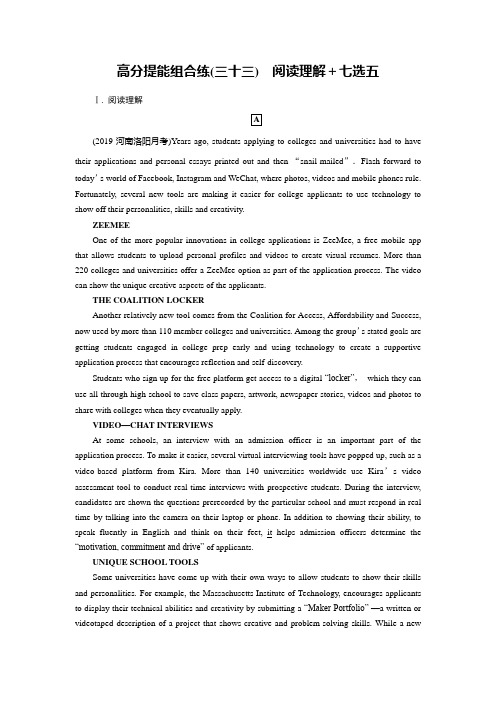
高分提能组合练(三十三)阅读理解+七选五Ⅰ. 阅读理解A(2019·河南洛阳月考)Years ago, students applying to colleges and universities had to have their applications and personal essays printed out and then “snail-mailed”.Flash forward to today’s world of Facebook, Instagram and WeChat, where photos, videos and mobile phones rule. Fortunately, several new tools are making it easier for college applicants to use technology to show off their personalities, skills and creativity.ZEEMEEOne of the more popular innovations in college applications is ZeeMee, a free mobile app that allows students to upload personal profiles and videos to create visual resumes. More than 220 colleges and universities offer a ZeeMee option as part of the application process. The video can show the unique creative aspects of the applicants.THE COALITION LOCKERAnother relatively new tool comes from the Coalition for Access, Affordability and Success, now used by more than 110 member colleges and universities. Among the group’s stated goals are getting students engaged in college prep early and using technology to create a supportive application process that encourages reflection and self-discovery.Students who sign up for the free platform get access to a digital “locker”,which they can use all through high school to save class papers, artwork, newspaper stories, videos and photos to share with colleges when they eventually apply.VIDEO—CHAT INTERVIEWSAt some schools, an interview with an admission officer is an important part of the application process. To make it easier, several virtual interviewing tools have popped up, such as a video-based platform from Kira. More than 140 universities worldwide use Kira’s video assessment tool to conduct real-time interviews with prospective students. During the interview, candidates are shown the questions prerecorded by the particular school and must respond in real time by talking into the camera on their laptop or phone. In addition to showing their ability, to speak fluently in English and think on their feet, it helps admission officers determine the “motivation, commitment and drive” of applicants.UNIQUE SCHOOL TOOLSSome universities have come up with their own ways to allow students to show their skills and personalities. For example, the Massachusetts Institute of Technology, encourages applicants to display their technical abilities and creativity by submitting a “Maker Portfolio”—a written or videotaped description of a project that shows creative and problem-solving skills. While a newapp would fit the bill, the project could be anything from an origami design to a potato cannon.[语篇解读]本文是一篇应用文。
2020年高考英语刷题高分提能组合练10
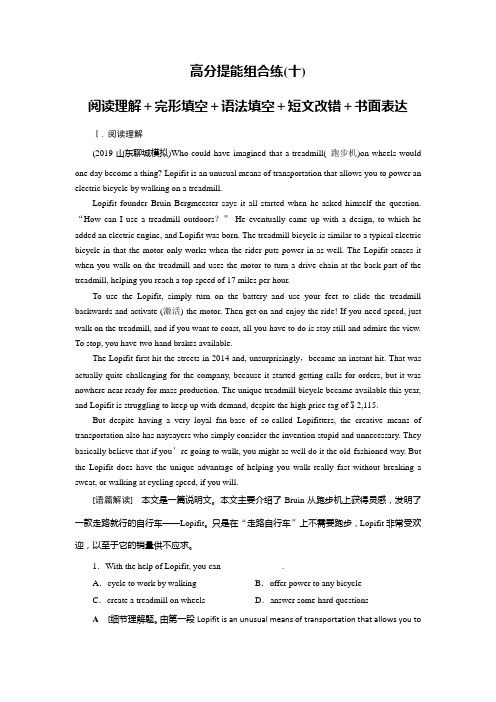
高分提能组合练(十)阅读理解+完形填空+语法填空+短文改错+书面表达Ⅰ. 阅读理解(2019·山东聊城模拟)Who could have imagined that a treadmill( 跑步机)on wheels would one day become a thing? Lopifit is an unusual means of transportation that allows you to power an electric bicycle by walking on a treadmill.Lopifit founder Bruin Bergmeester says it all started when he asked himself the question. “How can I use a treadmill outdoors?”He eventually came up with a design, to which he added an electric engine, and Lopifit was born. The treadmill bicycle is similar to a typical electric bicycle in that the motor only works when the rider puts power in as well. The Lopifit senses it when you walk on the treadmill and uses the motor to turn a drive chain at the back part of the treadmill, helping you reach a top speed of 17 miles per hour.To use the Lopifit, simply turn on the battery and use your feet to slide the treadmill backwards and activate (激活) the motor. Then get on and enjoy the ride! If you need speed, just walk on the treadmill, and if you want to coast, all you have to do is stay still and admire the view. To stop, you have two hand brakes available.The Lopifit first hit the streets in 2014 and, unsurprisingly,became an instant hit. That was actually quite challenging for the company, because it started getting calls for orders, but it was nowhere near ready for mass production. The unique treadmill bicycle became available this year, and Lopifit is struggling to keep up with demand, despite the high price tag of $ 2,115.But despite having a very loyal fan-base of so-called Lopifitters, the creative means of transportation also has naysayers who simply consider the invention stupid and unnecessary. They basically believe that if you’re going to walk, you might as well do it the old-fashioned way. But the Lopifit does have the unique advantage of helping you walk really fast without breaking a sweat, or walking at cycling speed, if you will.[语篇解读]本文是一篇说明文。
2020年高考英语刷题高分提能组合练9
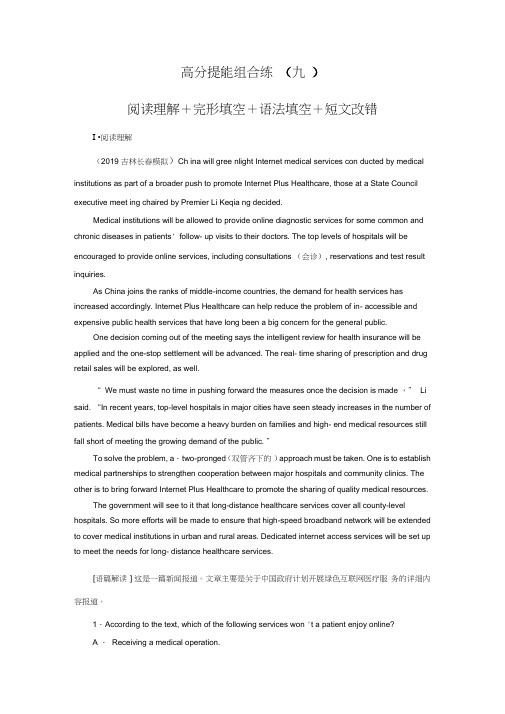
高分提能组合练(九)阅读理解+完形填空+语法填空+短文改错I •阅读理解(2019 吉林长春模拟)Ch ina will gree nlight Internet medical services con ducted by medical institutions as part of a broader push to promote Internet Plus Healthcare, those at a State Council executive meet ing chaired by Premier Li Keqia ng decided.Medical institutions will be allowed to provide online diagnostic services for some common and chronic diseases in patients' follow- up visits to their doctors. The top levels of hospitals will be encouraged to provide online services, including consultations (会诊), reservations and test result inquiries.As China joins the ranks of middle-income countries, the demand for health services has increased accordingly. Internet Plus Healthcare can help reduce the problem of in- accessible and expensive public health services that have long been a big concern for the general public.One decision coming out of the meeting says the intelligent review for health insurance will be applied and the one-stop settlement will be advanced. The real- time sharing of prescription and drug retail sales will be explored, as well.“ We must waste no time in pushing forward the measures once the decision is made ,” Li said. “In recent years, top-level hospitals in major cities have seen steady increases in the number of patients. Medical bills have become a heavy burden on families and high- end medical resources still fall short of meeting the growing demand of the public. ”To solve the problem, a.two-pronged (双管齐下的) approach must be taken. One is to establish medical partnerships to strengthen cooperation between major hospitals and community clinics. The other is to bring forward Internet Plus Healthcare to promote the sharing of quality medical resources.The government will see to it that long-distance healthcare services cover all county-level hospitals. So more efforts will be made to ensure that high-speed broadband network will be extended to cover medical institutions in urban and rural areas. Dedicated internet access services will be set up to meet the needs for long- distance healthcare services.[语篇解读] 这是一篇新闻报道。
2020版高考英语刷题高分提能组合练 (10)
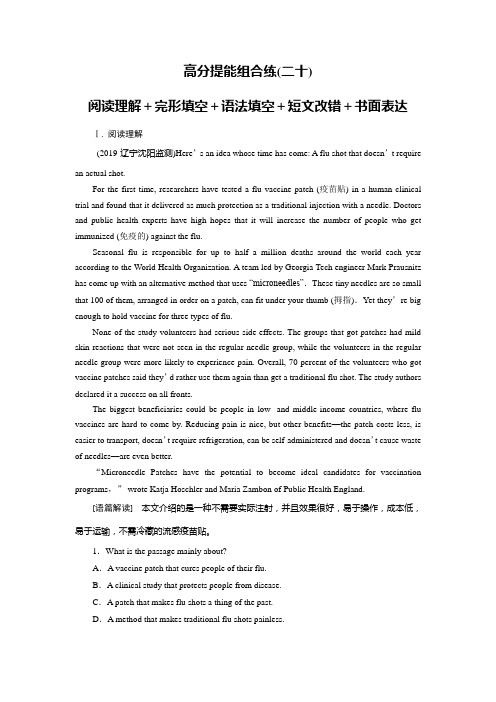
高分提能组合练(二十)阅读理解+完形填空+语法填空+短文改错+书面表达Ⅰ. 阅读理解(2019·辽宁沈阳监测)Here’s an idea whose time has come: A flu shot that doesn’t require an actual shot.For the first time, researchers have tested a flu vaccine patch (疫苗贴) in a human clinical trial and found that it delivered as much protection as a traditional injection with a needle. Doctors and public health experts have high hopes that it will increase the number of people who get immunized (免疫的) against the flu.Seasonal flu is responsible for up to half a million deaths around the world each year according to the World Health Organization. A team led by Georgia Tech engineer Mark Prausnitz has come up with an alternative method that uses “microneedles”.These tiny needles are so small that 100 of them, arranged in order on a patch, can fit under your thumb (拇指).Yet they’re big enough to hold vaccine for three types of flu.None of the study volunteers had serious side effects. The groups that got patches had mild skin reactions that were not seen in the regular needle group, while the volunteers in the regular needle group were more likely to experience pain. Overall, 70 percent of the volunteers who got vaccine patches said they’d rather use them again than get a traditional flu shot. The study authors declared it a success on all fronts.The biggest beneficiaries could be people in low-and middle-income countries, where flu vaccines are hard to come by. Reducing pain is nice, but other benefits—the patch costs less, is easier to transport, doesn’t require refrigeration, can be self-administered and doesn’t cause waste of needles—are even better.“Microneedle Patches have the potential to become ideal candidates for vaccination programs,” wrote Katja Hoschler and Maria Zambon of Public Health England.[语篇解读]本文介绍的是一种不需要实际注射,并且效果很好,易于操作,成本低,易于运输,不需冷藏的流感疫苗贴。
2020版高考英语刷题高分提能组合练1
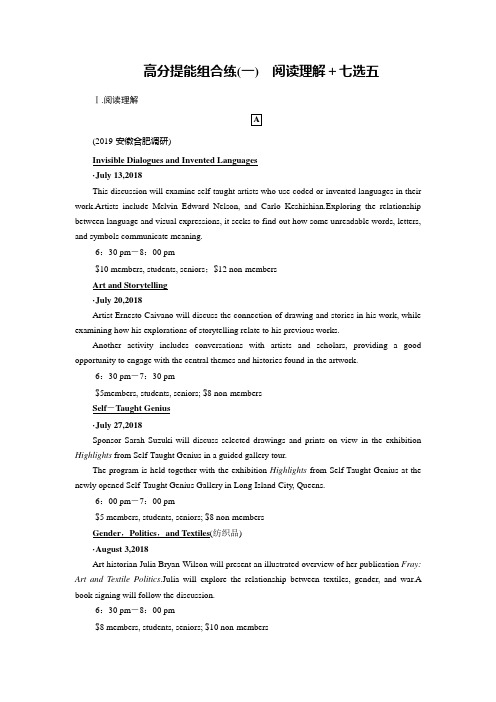
高分提能组合练(一)阅读理解+七选五Ⅰ.阅读理解A(2019·安徽合肥调研)Invisible Dialogues and Invented Languages·July 13,2018This discussion will examine self-taught artists who use coded or invented languages in their work.Artists include Melvin Edward Nelson, and Carlo Keshishian.Exploring the relationship between language and visual expressions, it seeks to find out how some unreadable words, letters, and symbols communicate meaning.·6:30 pm-8:00 pm·$10 members, students, seniors;$12 non-membersArt and Storytelling·July 20,2018Artist Ernesto Caivano will discuss the connection of drawing and stories in his work, while examining how his explorations of storytelling relate to his previous works.Another activity includes conversations with artists and scholars, providing a good opportunity to engage with the central themes and histories found in the artwork.·6:30 pm-7:30 pm·$5members, students, seniors; $8 non-membersSelf-Taught Genius·July 27,2018Sponsor Sarah Suzuki will discuss selected drawings and prints on view in the exhibition Highlights from Self-Taught Genius in a guided gallery tour.The program is held together with the exhibition Highlights from Self-Taught Genius at the newly opened Self-Taught Genius Gallery in Long Island City, Queens.·6:00 pm-7:00 pm·$5 members, students, seniors; $8 non-membersGender,Politics,and Textiles(纺织品)·August 3,2018Art historian Julia Bryan-Wilson will present an illustrated overview of her publication Fray: Art and Textile Politics.Julia will explore the relationship between textiles, gender, and war.A book signing will follow the discussion.·6:30 pm-8:00 pm·$8 members, students, seniors; $10 non-members[语篇解读]本文为应用说明文。
2020年高考英语刷题高分提能组合练4
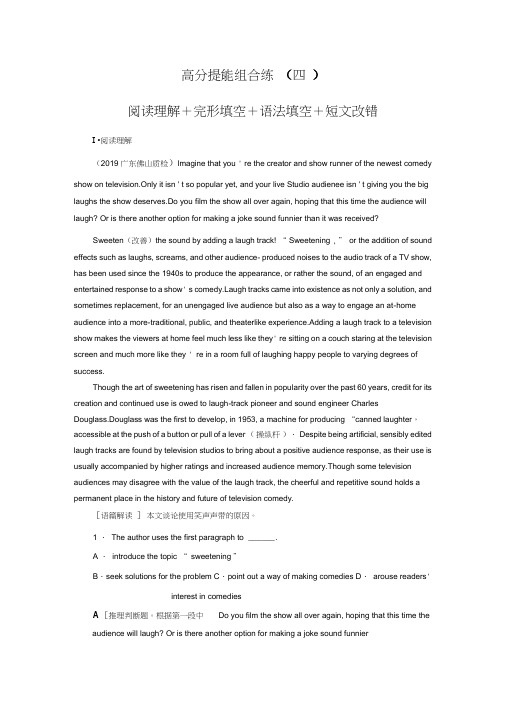
高分提能组合练(四)阅读理解+完形填空+语法填空+短文改错I •阅读理解(2019 广东佛山质检)lmagine that you ' re the creator and show runner of the newest comedy show on television.Only it isn ' t so popular yet, and your live Studio audienee isn ' t giving you the big laughs the show deserves.Do you film the show all over again, hoping that this time the audience will laugh? Or is there another option for making a joke sound funnier than it was received?Sweeten(改善)the sound by adding a laugh track! “ Sweetening , ” or the addition of sound effects such as laughs, screams, and other audience- produced noises to the audio track of a TV show, has been used since the 1940s to produce the appearance, or rather the sound, of an engaged and entertained response to a show' s ugh tracks came into existence as not only a solution, and sometimes replacement, for an unengaged live audience but also as a way to engage an at-home audience into a more-traditional, public, and theaterlike experience.Adding a laugh track to a television show makes the viewers at home feel much less like they' re sitting on a couch staring at the television screen and much more like they ' re in a room full of laughing happy people to varying degrees of success.Though the art of sweetening has risen and fallen in popularity over the past 60 years, credit for its creation and continued use is owed to laugh-track pioneer and sound engineer CharlesDouglass.Douglass was the first to develop, in 1953, a machine for producing “canned laughter,accessible at the push of a button or pull of a lever (操纵杆).Despite being artificial, sensibly edited laugh tracks are found by television studios to bring about a positive audience response, as their use is usually accompanied by higher ratings and increased audience memory.Though some television audiences may disagree with the value of the laugh track, the cheerful and repetitive sound holds a permanent place in the history and future of television comedy.[语篇解读]本文谈论使用笑声声带的原因。
- 1、下载文档前请自行甄别文档内容的完整性,平台不提供额外的编辑、内容补充、找答案等附加服务。
- 2、"仅部分预览"的文档,不可在线预览部分如存在完整性等问题,可反馈申请退款(可完整预览的文档不适用该条件!)。
- 3、如文档侵犯您的权益,请联系客服反馈,我们会尽快为您处理(人工客服工作时间:9:00-18:30)。
高分提能组合练(三十四)阅读理解+完形填空+语法填空+短文改错Ⅰ. 阅读理解(2019·吉林长春模拟)In the story of “The crow and the pitcher”from Aesop’s Fables, a thirsty crow (乌鸦) drops stones into a narrow jar to raise the low level of water inside so he can take a drink.Now scientists have evidence to back up that story. Crows actually do understand how to make water displacement (移位) work to their advantage, experiments show. The results suggest that the birds are, at least in some aspects, as smart as first-graders.Researchers, led by Sarah Jelbert at the University of Auckland in New Zealand, presented six crows with tubes filled with water. Inside the tubes, a worm or piece of meat on a piece of wood was floating, just out of reach of the crow. In front of the tubes, the researchers arranged several rubber erasers that would sink, and some plastic objects that would float. The crows found out that they could drop the erasers into the tubes in order to raise the water level and get their snack.However, the_birds_handled_awkwardly in experiments in which they could choose to drop objects in either a wide tube or a narrow one to get a snack, the researchers said. Dropping objects into narrow tube would lift the water level by a greater amount and put the treat within reach after just two drops; while it took around seven drops to raise the snack to the same level in the wide tube. The crows obviously didn’t realize this, and most of them went for the wide tube first.Previous studies showed that chimps and human children can solve similar tasks. In a 2011 study, chimps and kids found out that they could put water into a tube to reach a peanut that was floating in a small amount of water at the bottom.[语篇解读]这是一篇科普类文章。
文章主要讲了科学家通过喝水实验对乌鸦智商的研究。
1.How did the crows get the snack in Sarah’s experiment?A.By breaking the tube. B.By dropping in erasers.C.By standing on the wood. D.By removing the wood.B[细节理解题。
根据第三段“The crows found out that they could drop the erasers into the tubes in order to raise the water level and get their snack. ”可知,乌鸦能够把橡皮擦扔到管子里,使食物浮起,然后吃到食物。
]2.What does the author mean by the birds handled awkwardly in Paragraph 4?A.They were unable to tell different shapes.B.They dropped objects only into narrow tubes.C.They were not aware of the snack at first sight.D.They mostly avoided the easier way to get the snack.D[语句猜测题。
从第四段可知,实验中的乌鸦在面对粗细不同的管子时,虽然细管比粗管需要更少的水和时间就可以把食物浮起来,但是乌鸦往往先去粗管那边,而没有选择更容易浮起食物的细管。
由此可知,这一句话的意思应该是“鸟儿大多没有选择更容易的方式得到零食”。
]3.What does the text mainly focus on?A.Stories of Aesop’s Fables. B.The development of crows.C.Crows’intelligence. D.Human-animal communication.C[主旨大意题。
根据第二段“The results suggest that the birds are, at least in some aspects, as smart as first-graders. ”以及后面的几个实验可知,整篇文章都是围绕乌鸦的智商问题来展开的。
]4.What can we learn from the passage?A.Crows are almost as clever as first-graders in some respects.B.Crows understand water displacement completely.C.Chimps and children are much smarter than crows.D.The story of “The crow and the pitcher” lacks evidence.A[推理判断题。
根据第二段最后一句“The results suggest that the birds are, at least in some aspects, as smart as first-graders. ”可知,鸟儿在一些方面几乎跟一年级小学生一样聪明,所以选项A正确。
根据第四段的实验可知,乌鸦并不能很好地理解排水量问题,所以选项B 错误。
根据最后一段的实验可知,黑猩猩和儿童跟乌鸦一样可以解决类似的问题,这不能说明他们比乌鸦聪明,所以选项C错误。
第二段第一句“Now scientists have evidence to back up that story. ”可知,科学家们已经有关于这则寓言的证据了。
]Ⅱ. 完形填空When we got ready to go to the rink(溜冰场),Mom always helped me tie up my skates. Then she __1__her own. Mom and I had been coming to the rink every__2__since my lessons began. That was our deal. I went to __3__on Tuesdays, and we skated together on Sundays.When we were ready to__4__on the ice,Mom took my hand and put an arm around my shoulder. I looked up at Mom and smiled. She seemed__5__but still smiled back. I took a short gliding step,and she stepped with me,holding my hand tight. We went across the rink very__6__. After a few minutes,we__7__in the center of the rink. I gently took my__8__back from Mom’s and glided slowly away.While Mom stood still,I__9__the move my teacher taught me this week. I planted one foot on the__10__,leaning forward a little. I slowly raised my back foot as__11__as I could behind me.I stopped and__12__a moment when some bigger kids skated quickly by. “OK,Mom. It’s__13__,”I said. “In fact,there is__14__to be afraid of. Skating alone is no__15__than skating with me. ”Then I did what my teacher did when he was teaching a__16__skater. “Watch my face,Mom,” I said. “Not your feet. Now,step. ”She took a baby step and__17__. We stayed until Mom could skate across the rink three times by herself. __18__she was done,she glided over to me and gave me a big hug. “I__19__you could do it,” I said.She smiled and said,“I couldn’t have done it without my excellent__20__. ”[语篇解读]作者虽小,却耐心地教妈妈学溜冰。
